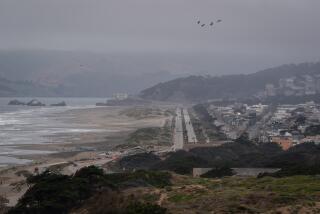Satellite Campus Plan Is a Dream Come True for MiraCosta College
It has been a decade now since MiraCosta College wooed and won the affluent populace to the south of its Oceanside-Carlsbad boundaries. In a dignified tug of war with neighboring Palomar College, the upstart Oceanside campus spread its district skirts south to encircle Del Mar and Rancho Santa Fe, Solana Beach and San Dieguito.
Now MiraCosta seeks to deliver on a promise that it made to those southerners--a pledge to build them a college campus of their own.
When, in 1975, the California Post-Secondary Education Commission, an arm of the state Legislature set up to deal with sticky educational issues, decreed that the coastal area south of Carlsbad and north of the San Diego Unified School District boundaries belonged to MiraCosta, few of the affected residents knew where the hilltop MiraCosta campus was. Fewer cared.
Back then, it was Palomar College in San Marcos that claimed the cream of the San Dieguito High graduates who had decided to commute to college rather than leave for far-flung universities and a dormitory life elsewhere. Even today, Palomar ranks as the top two-year college for live-at-home scholars in the San Dieguito area despite its distance from the coastal communities, 15 to 20 miles over backcountry roads or even farther by freeway.
MiraCosta officials believe that Palomar’s dominance will wane when MiraCosta’s San Elijo Center opens its doors in the fall of 1987 on the northern shore of the lagoon of the same name and near the geographical center of the southern district. With its 47-acre site serving as a perfect billboard for Interstate 5 commuters and with the accelerating growth of the San Dieguito area and the Del Mar-Rancho Santa Fe region, the satellite campus is expected to be at full enrollment on opening day without denting the Oceanside campus attendance.
John MacDonald, former president of MiraCosta and now an Oceanside city councilman, admits that the community college was not welcomed with open arms by its southern neighbors when the state commission summarily annexed the region to the college district. Many good-will sorties were made by MacDonald and other MiraCosta officials into the area to try to convince residents to break their ties with Palomar and support the eastern Oceanside campus.
“Promises were made and kept,” MacDonald said, in an effort to bind the southern area to the MiraCosta district in those early days. The college’s board of trustees was restructured to give southerners two seats and a voice on the seven-member group. A storefront campus was opened in Solana Beach in 1978 and later a satellite campus was created at a leased Del Mar elementary school to provide nearby educational offerings. San Dieguito High School District classrooms were used, often at night, to bring courses to the students in hopes of countering a statewide downward trend in community college enrollments.
Still, the southern area--comprising nearly half of MiraCosta’s potential student body--was supplying less than 18% of the college’s enrollment.
“We didn’t know exactly where the students from San Dieguito and that area were going,” MacDonald said, “but they weren’t coming here.”
The final effort to cement the southern sector to its established Oceanside-Carlsbad district was the seemingly divisive one of creating a second campus--a pledge that had been made earlier by MiraCosta officials and campaigning southern-area trustees. But, after the 1978 passage of Proposition 13 put a halt to increased property tax revenues for local governments, including colleges, MiraCosta trustees shelved construction plans for a San Dieguito campus. College officials chose to spend limited construction funds on the Oceanside campus. Some pre-Proposition 13 construction money squirreled away for a future San Dieguito campus went, instead, to maintain MiraCosta’s few “frills,” music, art, library and theater pursuits more expensive to offer than the meat-and-potatoes menu of college prep and vocational courses.
With the decade of the 1980s, however, eyes turned again to MiraCosta’s southern region, partly because of studies showing that the area was growing at a much faster rate than Oceanside-Carlsbad and especially because of the advent of North City West, a 40,000-resident future planned community about to take shape in the southernmost portion of the community college district.
In the fall of 1980, MiraCosta trustees approved the purchase of the San Elijo site for $1.6 million and began studies of its satellite’s potential student body. The results showed that it was not the fresh-faced high school grad who would dominate the new campus’s enrollment. Instead, the San Elijo Center’s typical student would be a 31-year-old divorcee, employed and with at least one child, either attending college to better her job or retraining herself for re-entry into the working world.
In a way, this made architect Gene Weston’s job a bit easier. He could erase any requirements for large athletic fields or massive student activity centers and substitute snack bars and a multipurpose outdoor court or two. His architectural design is one of low-slung, earth-toned buildings and tree-lined walkways stair-stepped up the slopes of the valley--a far cry from the imposing freeway advertisement that MiraCosta trustees initially had envisioned.
The metamorphosis of the San Elijo campus came about partly through the wishes of San Dieguito residents, partly because of the budgetary constraints, but mostly because of the requirements of the state Coastal Commission.
John Mullender, MiraCosta vice president of business services, has shepherded the San Elijo campus growth through its many stages and designs, including what he termed “the nightmare” of obtaining state Coastal Commission approval.
To quell concerns of citizens, county traffic engineers and coastal commissioners, Mullender said, 5.6 acres of the already-cramped campus had to be given up as right-of-way for a new four-lane Manchester Avenue, student enrollment had to be limited to 3,000, parking had to be provided for more than 800 cars, special (“and awfully expensive”) drainage structures had to be designed to prevent any unfiltered water runoff from the campus reaching the adjacent San Elijo Lagoon and a portion of the tract had to be designated as open space.
What Mullender remembers as a “frustrating” and blood pressure-elevating confrontation, Chuck Damm, assistant district director of the Coastal Commission, recalls as “quite routine for review of a project of that size.” Damm is pleased with the results of the commission’s permit reviews, which he said addressed all the environmental concerns that had caused the commission to turn down other proposed projects along the lagoon’s shores.
Damm said that the many conditions attached to the college’s permit include a provision that if a bus shuttle is ever put into operation in the Cardiff area, the college must reserve half the parking lot as a park-and-ride lot on weekends so that beach goers will at last have a place to leave their cars after the small lot at Cardiff State Beach is filled.
Damm said Mullender’s description of the commission’s permit processing as a nightmare was probably just an overreaction by an educational official who has never been faced with conforming to local regulatory agencies’ requirements.
The coastal panel’s restriction on students and Weston’s low-key design also calmed some earlier concerns voiced by MiraCosta’s main campus faculty members that the infant campus might grow up to overshadow the parent--the Oceanside-Carlsbad campus.
One retired faculty member, who now favors the San Elijo satellite, admitted he fought the satellite campus because he viewed it as a competitor for scarce funds needed to improve the Oceanside campus. But now, he said, “maybe because I am out of the rat race, I can see that if MiraCosta is going to grow and be competitive with Palomar and other community colleges, it has to expand south. And the only way to do it is to give them their own campus.”
Barring last-minute glitches or over-budget bids, the first work on the San Elijo Center--construction of the outsized parking lot, plus grading and landscaping of the entire campus, a $2-million job--should begin in early April. Construction of the first buildings should follow in five or six months, with completion targeted for the fall semester of the 1987 school year.
First will come the specialized educational facilities, the laboratories and library, each building having classrooms which will be used for expansion space when classroom buildings are constructed in several years.
Weston said his satellite campus design is flexible, able to conform to whatever the student population dictates. Everything, however, is scaled down from the Oceanside campus, such as the mini-multipurpose room between the music and art wings of the performing arts building, and the mini-student center featuring vending machines. All buildings will be air conditioned, he said, but the air conditioning will shut off the moment a window or door is opened.
When the campus is complete, which probably won’t occur before the 1990s, he said, the construction cost will be about $12 million in 1986 dollars.
Not too high a price to pay for striking the crimson-and-gray Palomar College banners of Palomar College and planting the red-and-white colors of MiraCosta on the shores of San Elijo Lagoon and in the hearts of San Dieguito students.
More to Read
Sign up for Essential California
The most important California stories and recommendations in your inbox every morning.
You may occasionally receive promotional content from the Los Angeles Times.









